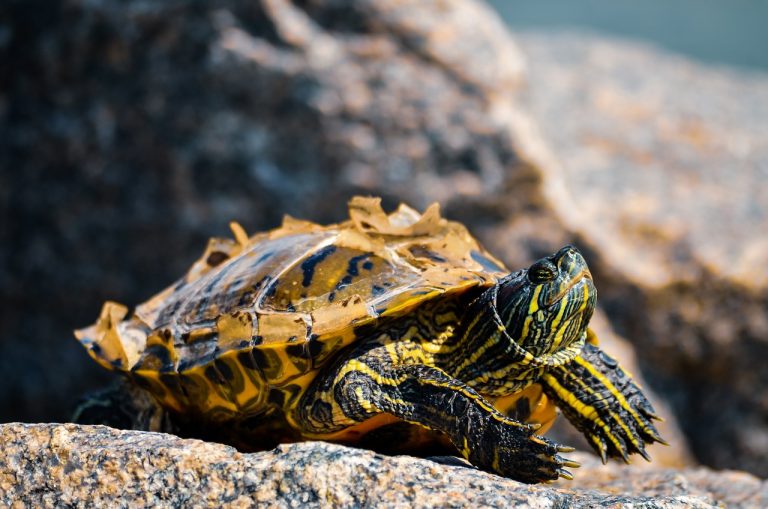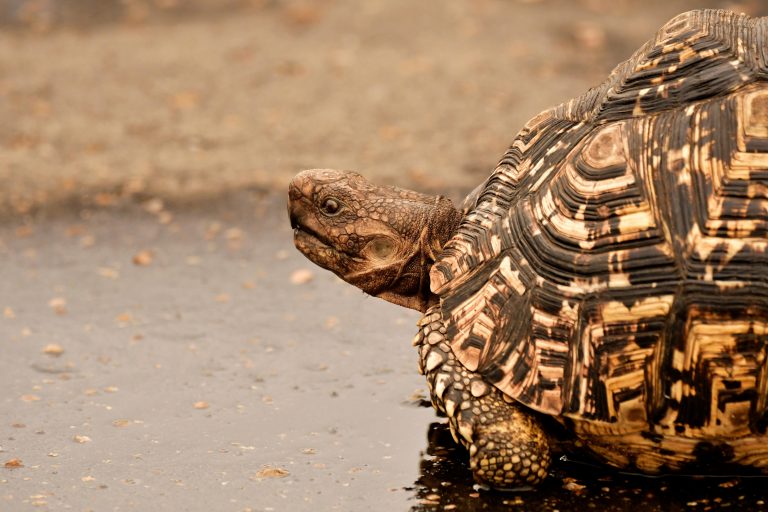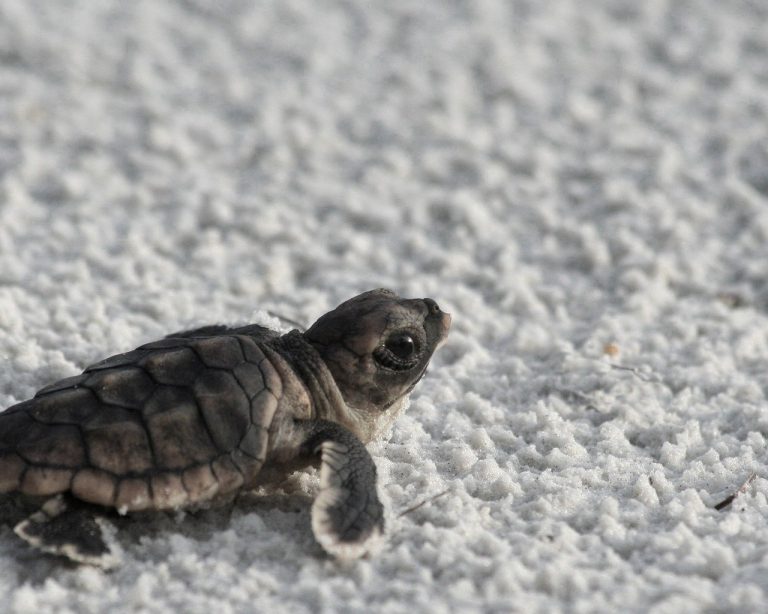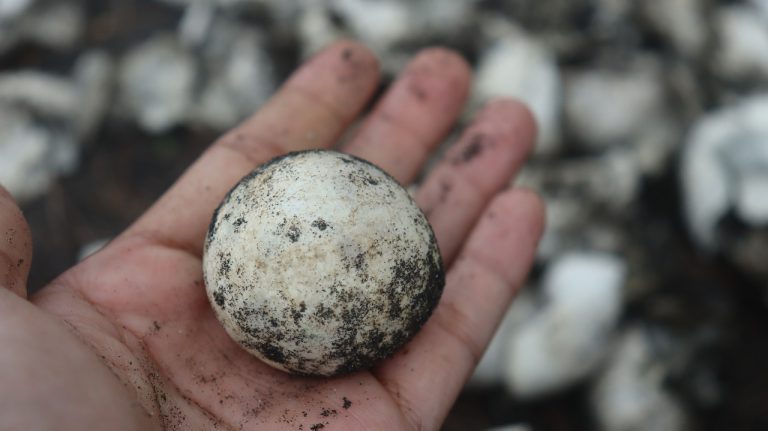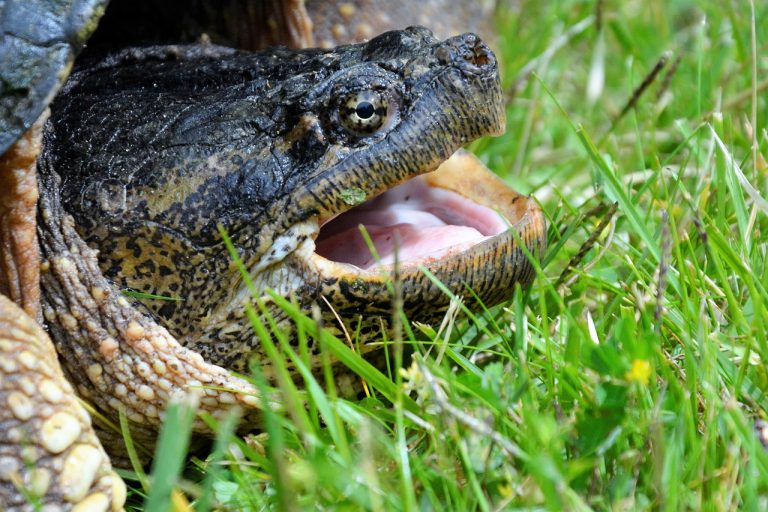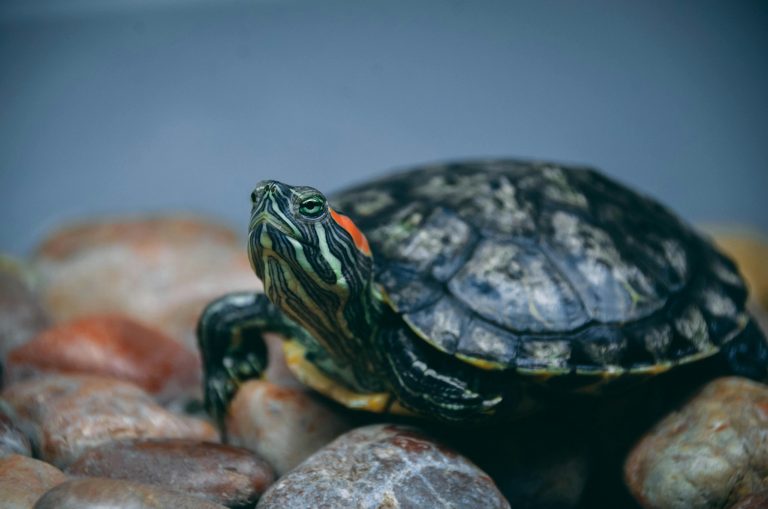Chicken Turtle Care For Beginners [Comprehensive Handbook]
The moment I heard the name “Chicken turtle,” I was sold. There’s something charmingly quirky about it, don’t you think? But, as any pet owner knows, bringing a new critter into your home is just the beginning of the adventure. Now came the task of ensuring this little shelled friend of mine thrives under my care. Lucky for you, I’m more than willing to spill the beans on how to give a chicken turtle the good life.
For starters, if you’re getting a male chicken turtle, you’ll need a tank that’s at least 75 gallons. Females? Well, they’ll need a bit more space, so think along the lines of a 125-gallon tank. Creating a cozy habitat means mimicking their natural digs, so that means lights, a heater to keep them warm and toasty, and of course, a filter to keep things clean and tidy.
Now, onto dinner time. When they’re little, chicken turtles are all about that protein life, but as they grow up, they fancy a mix of meats and greens. So, think balanced meals here – proteins, veggies, and a sprinkle of dietary supplements to keep them in tip-top shape.
But hey, if you’re hungry for more info, stick around.
Here are a few nuggets to chew on:
- Chicken turtles hail from the Southern USA and usually max out at around 10 inches.
- They’re a solid pick for newbie pet owners.
- And hey, good news – these guys aren’t endangered, so finding one to call your own shouldn’t be too tricky.
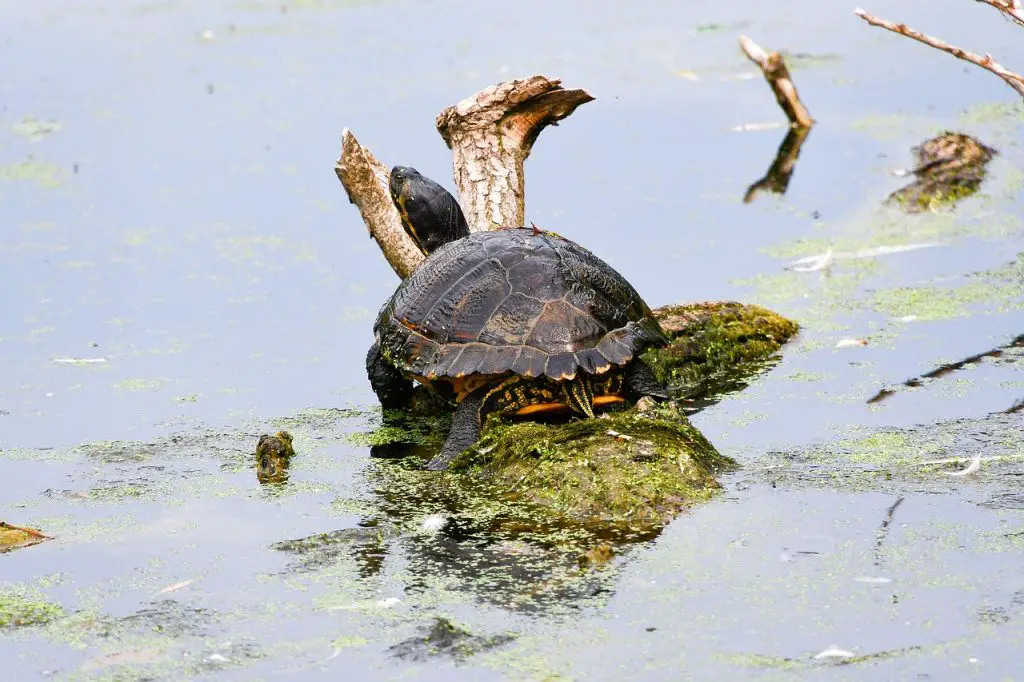
Chicken Turtle: Species Introduction
“Know your turtle first” – that’s been my mantra from day one. Before welcoming any new member into the family, whether furry, feathered, or shelled, I make it my mission to delve deep into their world. It’s all about understanding their quirks, their preferences, and what makes them tick. Because let’s face it, every creature deserves a life that’s not just good, but great.
So, naturally, when it came to the chicken turtle, I dove headfirst into research. I wanted to know everything – from their favorite snacks to the kind of habitat they thrive in. And let me tell you, it’s been quite the journey.
So, why don’t we kick things off with a little introduction to our star of the show – the chicken turtle? Let’s dive in.
Why These Turtles Are Named ‘Chicken Turtles’?
Ever wonder why they’re called chicken turtles? Well, it’s not because they cluck or lay eggs like our feathered friends. No, the name comes from something a bit more unexpected – their taste.
You heard that right. These turtles supposedly have a flavor reminiscent of chicken. But hold your frying pans, folks, because it’s not just a random coincidence. Back in the day, people actually used to chow down on these little guys, considering them a delicacy of sorts.
So, when you think about it, the name “chicken turtle” isn’t really about the turtles themselves. It’s more about how humans have interacted with them over time. It’s like a little nod to our culinary history and the role these creatures played in it.
This kind of naming isn’t uncommon. In fact, lots of animals get monikers based on how they’re useful to us or some standout quality that catches our attention. It’s just one of those quirks of human nature, I suppose.
Are There Types Of Chicken Turtles?
You betcha, Chicken Turtles aren’t just a one-size-fits-all deal – they come in different flavors, so to speak. Let’s break it down:
Eastern Chicken Turtle:
- Where to Find Them: Hanging out mainly in the southeastern United States, from Virginia down to Florida, and stretching westward to eastern Texas.
- Shell Style: Picture a shell with a fine, net-like pattern, topped off with a long, striped neck for that distinctive look.
- Habitat Hangouts: These guys are all about freshwater spots like ponds, marshes, and those lazy, slow-moving streams.
- Other Tidbits: They’re like the ambassadors of the southeastern US, perfectly suited to their neck of the woods.
Florida Chicken Turtle:
- Where to Find Them: No surprise here – they’re Florida natives through and through.
- Shell Chic: Similar vibes to their Eastern cousins, but with a bit more pizzazz – think brighter colors and a touch of flair.
- Hangout Spots: They’re all about the same freshwater haunts as the Eastern crew, just with that sunny Florida twist.
- Extra Info: Smaller in size but big on personality, these turtles bring a splash of color to the party.
Western Chicken Turtle:
- Where to Find Them: Roaming around the central and southwestern United States, though they’re a bit rarer than the other two.
- Shell and Skin Style: Their shells and skin sport a slightly different look compared to their eastern cousins – think of it as their own unique fashion statement.
- Preferred Digs: They’re all about those freshwater hangouts, just like the others, but they’ve got their own vibe going on in the central and southwestern parts of the country.
- Fun Fact: You might not spot these guys as often, but when you do, they’re sure to catch your eye with their distinct style.
So there you have it – the lowdown on the different Chicken Turtle subspecies. Each one has its own charm, adapted to its corner of the world but united by that unmistakable Chicken Turtle flair.
Chicken Turtle Appearance: How Do They Look?
Ah, the curious case of the Chicken Turtle’s name – it’s a tale as old as time, or at least as old as the folklore surrounding these delightful reptiles.
One popular yarn spun about their moniker suggests that it’s all about the taste – apparently, some folks back in the day thought these turtles had a flavor akin to our feathered friends. Now, I know what you’re thinking – sounds a bit harsh, doesn’t it? But hey, it’s just a story, nothing more.
Another camp in the storytelling circle argues that the name comes from the turtles’ appearance. Picture this: long necks adorned with yellow stripes, giving them a vaguely chicken-like vibe. It’s a more light-hearted take on the name, don’t you think?
Now, let’s talk looks. Chicken Turtles are a sight to behold, with smooth, egg-shaped shells that boast an olive-tanned hue. But here’s where it gets interesting – those shells are decked out with a net-like pattern of yellow rings. And don’t forget about the plastrons – that’s the underside of the shell – which sport a cheerful yellow hue, free of any markings.
But wait, there’s more – three subspecies to be exact:
- Western Chicken Turtle (Deirochelys Reticularia Miaria): These fellas rock broad, orange or yellow lines on their shells, with a varied color range along the upper shell rims.
- Eastern Chicken Turtle (Deirochelys Reticularia Reticularia): They’re a bit more subdued compared to their Florida cousins, sporting narrow green or brown lines on their shells. Their upper shell rims are adorned with slender color bands, and you’ll spot black markings on the lateral and rear marginals.
- Florida Chicken Turtle (Deirochelys Reticularia Chrysea): Now, these are the flashy ones, boasting bold orange and yellow lines on their shells. Their upper shell rims are quite the showstopper, and their appearance is unmistakable.
And here’s a little nugget of trivia for you – keep an eye out for those vertical yellow and black stripes at the back end of these critters. Oh, and don’t forget about their claws – sharp and pointy, just like you’d expect from a creature with such personality.
Chicken Turtle Habitat: Where Do Chicken Turtles Live?
If you’re a regular reader of my blogs, you’ll know that I’m all about advocating for adopting turtles that are native to your neck of the woods. And when it comes to Chicken Turtles, they’re true Southern belles and beaus, hailing from the coastal plains of the Southern USA.
Now, let’s narrow down their stomping grounds a bit. Eastern Chicken Turtles are all about the east coast of the Mississippi River, while their Western counterparts venture a bit further north, setting up shop in Northern Florida and along the middle of the eastern shore.
And then there’s the Florida Chicken Turtle – well, as you might guess from the name, they’re pretty much the unofficial mascot of the Sunshine State. You’ll find them scattered across about two-thirds of the lower Florida area, soaking up that warm Florida sun.
But here’s the thing about Chicken Turtles – they’re not big fans of big reservoirs or permanent ponds. Nope, they prefer to keep it cozy in heavily vegetated streams, where the waters are shallow and the wetlands are plentiful. It’s all about that natural, wild habitat for these guys.
Chicken Turtle Quirky Behavior: Are They Aggresive?
You know, there’s this myth floating around that Chicken Turtles are these social butterflies who just can’t get enough of each other’s company. But let me tell you, from personal experience, that’s not always the case.
Sure, when it comes to the babies and the ladies, they’re usually as chill as can be. Peaceful coexistence all around, no drama, no fuss.
But then there are the males – oh boy, don’t even get me started. Those guys are a whole different story. I brought a couple of them home thinking we’d all be one big happy family, but let me tell you, it was like living with tiny, scaly tyrants.
They’d put on this act of being friendly and polite when they were on their own, but the moment you introduced another turtle into the mix, it was like flipping a switch. Suddenly, they’d go from Mr. Nice Guy to full-blown monster mode.
At first, I thought maybe it was just my turtles being a bit quirky. But nope, turns out it’s a common issue among male Chicken Turtles – they just don’t play well with others.
So, I’ve learned my lesson. These days, I make sure to give the male Chicken Turtles their own space, separate from the rest of the gang. It’s all about respecting their need for privacy and avoiding any unnecessary turtle tiffs. Trust me, it’s for the best.
Chicken Turtle Size: How Big Do They Get?
Chicken Turtles fall into the medium-size category, making them a perfect fit for those looking for a not-too-big, not-too-small reptilian companion.
On average, you’re looking at a carapace size ranging from 4 to 10 inches (15 to 25 cm). Although, there have been reports of some big boys reaching up to 12 inches (30 cm) – talk about a turtle with some serious swagger.
Now, how big your Chicken Turtle will ultimately get is a bit of a mixed bag. It all comes down to a few factors, like which subspecies they belong to, their age, and of course, their overall health.
Out of the three subspecies, the Western Chicken Turtles tend to be on the smaller side, while their Florida cousins can grow into some hefty specimens. But remember, a healthy turtle is a happy turtle, and sometimes, complicated illnesses can put a damper on their growth.
Here’s a fun tidbit for you – the ladies always take the cake when it comes to size, typically clocking in at around 1.5 times larger than the fellas. But hey, it’s not always a surefire way to tell who’s who. If you’re looking for a definitive answer, keep an eye on their tail size and cloaca. Generally, males will have a thicker tail and a slit-like cloaca located at the tip.
Now, let’s talk growth spurts. Check out this handy growth table, tracking the size of a Chicken Turtle throughout their life stages:
- Hatchling: 1 to 1.5 inches (2.5 to 3.8 cm)
- 1 Year: 2 to 3 inches (5.1 to 7.6 cm)
- 2 Years: 3 to 4 inches (7.6 to 10.2 cm)
- 3 Years: 4 to 5 inches (10.2 to 12.7 cm)
- 4 Years: 5 to 6 inches (12.7 to 15.2 cm)
- 5 Years: 6 to 7 inches (15.2 to 17.8 cm)
- Adult: 8 to 10 inches (20.3 to 25.4 cm)
But remember, these figures are just ballpark estimates. Each turtle is unique, and factors like diet, health, and living conditions can all play a role in their growth journey.
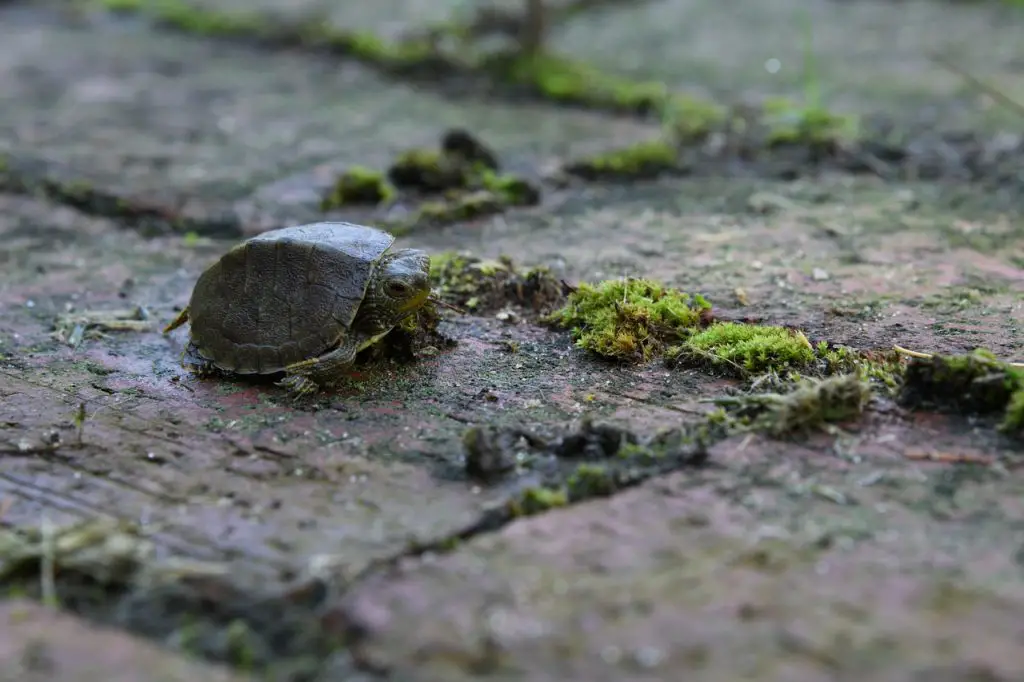
Chicken Turtle Lifespan: How Long Do They Live?
If you’re in the market for a turtle companion that’ll be with you for the long haul, I hate to break it to you, but Chicken Turtles might not be your best bet.
In their natural habitat, these little guys typically clock in at around 15 years of life, give or take. But when you bring them into captivity, that number drops down a bit, with an average life expectancy of around 13 years.
Now, don’t get me wrong – there have been some outliers in the research world, with reports of Chicken Turtles living well into their twenties. So, while the odds might not be in their favor for a super-long life, it’s not entirely out of the realm of possibility.
It all boils down to how you care for them. With the right habitat setup and top-notch care, Chicken Turtles in captivity can potentially stretch their lifespan to around 15 to 20 years. And hey, there have even been whispers of some individuals pushing past the 25-year mark out in the wild.
So, while they might not be breaking any records for longevity, knowing these little nuggets of info can help potential turtle owners understand the commitment they’re signing up for. After all, a little knowledge goes a long way when it comes to caring for our shelled friends.
Let’s Build A Home For The Chicken Turtles
Absolutely, let’s dive right into creating the perfect habitat for our Chicken Turtle pals! Here’s a breakdown of the ideal tank setup for Chicken Turtles at different stages of life:
| Chicken Turtle Life Stage | Tank Size | Substrate | Heating/Lighting | Hiding Spots | Additional Requirements |
|---|---|---|---|---|---|
| Hatchling (Baby) | For every 1-inch size of turtle, 15-20 gallons of water. Consider future growth and choose a tank size that will accommodate adult size. | Not necessary; can use for decoration. If used, choose large-size gravel or fluorite to prevent ingestion. | UVB light for full spectrum lighting and heat lamp for basking area. Maintain a day/night cycle with lights on for 12-14 hours. | Provide areas for hiding and feeling secure. | Powerful filtration system; canister filters recommended for effectiveness and ease of cleaning. Water heater if in a cooler environment; thermometer to monitor water and basking temperatures. Tank cover, preferably heatproof metal, to protect from external dangers and prevent escapes. |
| Juvenile | Similar to hatchlings, but adjust the tank size considering growth. | Same as hatchlings. | Same as hatchlings. | Same as hatchlings. | Same as hatchlings. |
| Adult | Spacious and sturdy; at least three times the length of the turtle in length, twice in width, and 1.5 to 2 times in height. | Same as hatchlings. | Same as hatchlings. | Same as hatchlings. | Same as hatchlings. |
Creating a comfortable and safe environment for Chicken Turtles is key to their well-being. Ensure the tank is spacious enough to accommodate their size and provides areas for basking, hiding, and swimming. Don’t forget to maintain proper lighting and heating to mimic their natural habitat, and invest in a quality filtration system to keep the water clean and healthy.
Once we have their home set up just right, we can move on to discussing their diet and ensuring they’re getting all the nutrients they need to thrive. Let’s keep the Chicken Turtle care train rolling!
Enclosure Size: Tank, Pool, Or Pond?
For beginners dipping their toes into the world of turtle care, the question of where to house their shelled companions can be a puzzling one. While the allure of an outdoor setup is undeniable, I always recommend starting with an indoor tank, especially for newbies.
Now, when it comes to Chicken Turtles, they’re not exactly giants in the turtle world. On average, they won’t surpass the 10-inch mark, though if you’ve got one that does, consider yourself blessed. My own adult Chicken Turtles typically measure in at a cozy 5 to 6 inches.
So, if you’re opting for an indoor setup, here’s the scoop: for adult Chicken Turtles, aim for a tank of at least 75 gallons. This size should comfortably accommodate a pair of young turtles or one adult male. But if you’ve got a lady in the mix, you’ll want to up the ante and go for a minimum of 125 gallons, or even more if needed to give her ample space.
Now, let’s talk outdoor living. While it might not be as common for Chicken Turtles, they can still adapt to the great outdoors with a bit of TLC. My recommendation? Start with a kiddie pool setup before you go all out and dig up a full-blown pond. Kiddie pools offer convenience and comfort for your turtles, making the transition a breeze.
As your turtles start to embrace their outdoor digs, you can consider making the move to a permanent outdoor pond. Just keep in mind that pond setups can be a bit pricey, and you’ll need to bring your turtles indoors during harsh weather to keep them safe and sound. Security is also a consideration, so make sure your outdoor setup is predator-proof.
Ultimately, the choice between indoor tanks, kiddie pools, or outdoor ponds comes down to your preferences and what works best for you and your shelled companions. As long as you’re providing a safe and comfortable habitat, your Chicken Turtles will feel right at home.
Basking Dock: Do Chicken Turtles Bask?
Creating a proper basking area for Chicken Turtles in captivity is crucial for their overall well-being, mimicking their natural habits in the wild. These turtles love to spend most of their time submerged in water but also enjoy basking occasionally to soak up the sunlight.
One effective method I’ve found is to craft a DIY basking dock using flat, smooth-edged rocks stacked together to form a platform. The key here is to ensure the water level is below the platform, allowing it to serve as both a basking spot and dry land area for your turtles.
Alternatively, placing a log inside the tank not only adds a natural touch to the habitat but also serves as a perfect basking spot when positioned under the basking light.
For those who prefer a hassle-free option, commercial docks available at pet stores are also a convenient choice.
Regardless of the method chosen, it’s essential to ensure easy access for the turtles to the basking platform, especially if multiple turtles are present. If needed, constructing a ramp can provide easier access. Additionally, the dock should be sturdy enough to support the weight of multiple turtles to prevent any accidents. By providing a suitable basking area, you’re helping to replicate their natural environment and promoting their overall health and happiness.
Artificial Lighting Arrangements For Chicken Turtles
You’ve hit the nail on the head – heat and UV rays are absolute must-haves when it comes to keeping Chicken Turtles happy and healthy in captivity. Let’s break it down:
Heating Lamp:
- Chicken Turtles rely on external heat sources to regulate their body temperature, especially when kept indoors where access to sunlight is limited.
- Installing a heating or basking lamp above the basking dock provides the necessary warmth. The lamp’s angle creates a temperature gradient in the tank, mimicking their natural environment.
- The distance between the lamp and the dock depends on the bulb’s power. Here’s a rough guideline:
- 50 watt: 5 to 7 inches
- 75 watt: 7 to 9 inches
- 100 watt: 10 to 12 inches
- 150 watt: More than 12 inches
- Without proper heating, Chicken Turtles may enter unplanned hibernation, which can be dangerous for their health.
UV Bulbs:
- UV light is crucial for Chicken Turtles’ mental and physical well-being.
- UVA rays keep them relaxed, while UVB rays promote vitamin D3 production, aiding in calcium absorption and immunity.
- Opt for quality UV bulbs, as cheaper alternatives may not provide adequate UVA or UVB radiation.
- The distance between the UV bulb and the dock varies based on its percentage:
- 2.5% UV: 12 inches
- 3% UV: 14 to 16 inches
- 5% UV: 18 inches
- 10% UV: More than 18 inches
- Some bulbs offer both heating and UV functions, providing convenience without compromising on quality.
Other Lights:
- Avoid installing night lights in the enclosure, as they can disrupt the turtles’ sleep cycle. Turtles don’t need lights to see in the dark and rely on closed-eye sleep.
- Consider using a blue or red light during cold nights for hatchlings, as it provides gentle warmth without interfering with their sleep.
By ensuring proper heating and UV lighting, you’re creating a comfortable and healthy environment that mimics the Chicken Turtles’ natural habitat, allowing them to thrive in captivity.
Do Chicken Turtles Need A Water Heater?
You’re absolutely right – a water heater is a crucial piece of equipment when it comes to maintaining the well-being of indoor Chicken Turtles. After all, we’ve already discussed the importance of warmth for these reptiles, and that extends to their aquatic environment as well.
Now, if you happen to reside in an area where summers are scorching hot, you might find that you can give the water heater a break during those sweltering days. Simply keep an eye on the water temperature with a trusty thermometer, checking it regularly to ensure it remains within the optimal range for your turtles’ comfort.
However, as we transition into late autumn and winter, when the weather starts to cool down and chilly nights become more frequent, that’s when the water heater becomes an absolute necessity. Trust me, your turtles will thank you for it.
Now, let’s talk quality. I cannot stress this enough – please, please avoid skimping on a water heater. Opting for cheap, low-quality heaters might seem like a money-saving move, but it’s a red alert waiting to happen. These inferior devices often fail to provide accurate temperature control, and their wiring systems may not meet safety standards, putting your precious turtles at risk of electrocution if things go awry.
Investing in a digital water heater might seem like a hefty upfront cost, but let me tell you, it’s worth every single penny. These advanced heaters can track and regulate the water temperature with precision, ensuring that your turtles are always kept cozy and comfortable in their aquatic habitat.
So, let’s not leave our turtles out in the cold – or worse, in chilly water. Install a quality water heater, keep it turned off when not needed, and rest easy knowing that your shelled companions are living their best, warmest lives.
Should You Install A Water Filter?
It’s surprising how often keepers overlook the importance of a water filter in their Chicken Turtle enclosures. Without one, the habitat can quickly turn into a smelly, unsanitary mess that nobody – including your turtles – wants to be around.
Let’s face it, our turtles may be smart, but they’re not exactly tidy. They’ll happily munch on their food and leave behind scraps, not to mention the inevitable waste they produce. Without a filtration system in place, all that debris settles at the bottom of the tank or pond, decomposing and releasing a foul odor that can make your home downright unpleasant.
That’s where a water filter comes to the rescue. For indoor aquarium setups, canister filters are the way to go, efficiently removing debris and maintaining water quality. If you’re dealing with a pond, whether indoors or outdoors, opt for a more powerful filter or even consider DIYing one to ensure thorough filtration.
Now, you might be wondering – how powerful should the filter be? Experts recommend selecting a filter that’s 1.5 to 2 times the size of your tank, ensuring it can effectively process water and keep things clean and fresh.
But filtration isn’t the only aspect of water care to consider. Take a look at this handy table detailing Chicken Turtle’s water needs:
| Parameter | Requirement | Notes |
|---|---|---|
| Water Change Schedule | Replace 25% of the water weekly; full change monthly. | A thorough tank cleaning is recommended once or twice a month. |
| Water Temperature | Range between 70 to 75 degrees Fahrenheit. | Use a heater if the water is too cold. |
| Water Depth | Minimum depth of three-quarters of the turtle’s length. | Most aquatic turtles prefer a water depth of 5 to 6 inches. |
| Water pH | Between 7 to 8. | Ideal pH range varies by species, so it’s best to consult an expert for specific needs. |
| Water Quality | Clean, safe water. | Distilled water is recommended for filling the tank. |
By staying on top of these parameters and ensuring proper filtration, you’ll provide your Chicken Turtles with a clean and healthy aquatic environment they’ll thrive in.
Decorations In Chicken Turtle Enclosure
Absolutely! Adding some color and natural elements to your Chicken Turtle’s enclosure can transform it from bland to beautiful. Here are some ideas to spruce up their habitat while keeping it natural and comfortable:
- Natural Basking Areas: Instead of a typical commercial dock, opt for logs or rock stacks to create a basking area. This not only adds visual interest but also provides a more natural environment for your turtles to enjoy.
- Substrate Variety: Layer the bottom of the tank with a combination of topsoil and colorful gravel. This not only adds a pop of color but also provides a more natural substrate for your turtles to explore and burrow into.
- Live Plants: Introduce live plants to the enclosure to create a lush, green environment. Not only do live plants add visual appeal, but they also help maintain water quality and provide natural hiding spots for your turtles.
- Hiding Places: Incorporate broad leaves, rocky caves, and broken pots into the decor to create hiding spots for your turtles. These hiding places provide privacy and security, helping your turtles feel more at ease in their environment.
By incorporating these decoration ideas, you can create an elegant and natural habitat for your Chicken Turtles that not only looks beautiful but also provides them with the comfort and enrichment they need to thrive.
Which Type Of Environment Do Chicken Turtles Like?
It’s true – Chicken Turtles can be quite particular about their environment, and even small mistakes in temperature regulation or water quality can lead to illness. Let’s dive into the specifics of their environmental requirements:
Temperature Regulation:
- Basking temperature: Keep the basking area between 75°F to 85°F to ensure your turtles can properly thermoregulate.
- Air temperature: Maintain the air temperature around the tank at 85°F to 90°F to create a comfortable environment for your turtles.
- Water temperature: Aim for a water temperature between 75°F to 80°F, ensuring it remains within this range consistently. You can slightly drop the temperature by 2 to 3 degrees at night to mimic natural temperature fluctuations.
Lighting Schedule:
- Provide 10 to 12 hours of lighting each day with heating and UV bulbs. Remember to turn them off after dark to simulate a natural day-night cycle. UV lamps should be replaced every 6 months to ensure your turtles receive adequate UV radiation.
Water Quality:
- Use fresh tap water for your turtles, but ensure the mineral contents are appropriate. Chicken Turtles are sensitive to high levels of chlorine, sulfate, and ammonia in the water.
- Maintain a pH range of 7.5 to 8 in the water, as this is suitable for your turtles’ health.
- Consider adding a commercial water conditioner to the water to remove harmful substances and prepare it for use in the tank. Allow the conditioner to work for several hours before introducing your turtles.
By carefully regulating the temperature, lighting, and water quality in your Chicken Turtle’s enclosure, you can provide them with a comfortable and healthy environment where they can thrive and remain happy and active.
What Is An Ideal Diet For Chicken Turtles?
Chicken Turtles exhibit an interesting dietary evolution as they grow, transitioning from aggressive carnivores in their youth to omnivores in adulthood. Understanding their nutritional needs at different life stages is crucial for ensuring their health and well-being.
Dietary Preferences:
In their early days, young Chicken Turtles are carnivorous hunters, enjoying a diet primarily consisting of small fish, crayfish, tadpoles, insects, and various invertebrates. As they mature, they gradually shift towards an omnivorous diet, incorporating a wider range of foods including fruits, vegetables, and leafy greens.
Meal Draft and Nutritional Needs:
When preparing meals for Chicken Turtles, it’s essential to provide a balanced diet that meets their nutritional requirements. Here’s a breakdown of their dietary needs at different life stages:
- Hatchlings: Feed 1-2 times daily with small, soft foods like chopped earthworms, mealworms, feeder fish, shrimp, and soft-bodied insects.
- Juveniles: Feed 2-3 times weekly, including the above foods as well as pellets, flakes, and frozen foods like chopped shrimp, silversides, and smelt.
- Adults: Feed 1-2 times weekly, offering a varied omnivorous diet that includes the above foods along with vegetables like dark, leafy greens.
Feeding Guidelines:
- Avoid feeding processed foods excessively, with pellets making up no more than 25% of their diet.
- Steer clear of feeding cat or dog foods to Chicken Turtles.
- Use the “head method” or the “15-minute method” to determine meal quantity, ensuring a balanced mix of protein and vegetables.
- Supplement meals with calcium to support their bone health.
Feeding Schedule:
- Feed hatchlings daily for the first 6 months, then switch to an every-other-day feeding routine.
- Adult Chicken Turtles may have a reduced appetite and can thrive on a twice-a-week feeding schedule.
By adhering to these feeding guidelines and providing a diverse and nutritious diet, you’ll ensure that your Chicken Turtles remain healthy, active, and happy throughout their lives.
Chicken Turtle Potential Diseases And Treatments
It’s true that while Chicken Turtles are known for their hardiness, they’re not immune to illness. Recognizing common diseases and health issues and understanding their symptoms, causes, and treatments is crucial for ensuring the well-being of your pets. Here’s a summary:
| Disease/Issue | Symptoms | Causes | Treatment |
|---|---|---|---|
| Respiratory infection | Runny nose, swollen eyes, labored breathing | Poor ventilation, low humidity, bacterial/fungal infection | Antibiotics, increase humidity |
| Metabolic bone disease (MBD) | Brittle shell, soft bones | Lack of UVB, calcium, vitamin D3 | Adjust lighting/supplements, correct husbandry |
| Shell rot | Soft, foul-smelling shell | Poor water quality, wounds, bacterial infection | Antibiotics, clean enclosure/water |
| Parasites | Lethargy, poor appetite, skin lesions | Contaminated food/water, unsanitary conditions | Fecal exam by vet, deworming meds |
| Eye/skin infections | Crusty eyes/skin, swelling | Bacterial/fungal causes | Antibiotics, antifungals |
Being vigilant and proactive in monitoring your Chicken Turtles’ health and addressing any signs of illness promptly can greatly improve their chances of recovery and overall well-being. Regular veterinary check-ups, proper husbandry practices, and a clean, well-maintained environment are essential for keeping your turtles healthy and thriving.
Understanding and addressing common diseases in Chicken Turtles is essential for ensuring their health and well-being. Here are a few common diseases discussed along with their symptoms and treatments:
- Hypovitaminosis: This condition arises from a lack of vitamin A in the diet, common in carnivorous chicken turtles. Symptoms include puffy eyes, dry skin, low immunity, and infectious illnesses. Treatment involves adding vitamin A-rich foods like carrots and green leafy vegetables to the diet, along with antibiotic shots.
- Shell Diseases: Untreated shell injuries can lead to severe shell rot. Even minor scratches can become infected, requiring veterinary intervention. Treatment may involve medication and, in severe cases, surgery to repair the shell.
- Metabolic Bone Disease (MBD): Caused by a lack of UVB exposure, resulting in insufficient production of vitamin D3 and calcium absorption. Symptoms include soft shells, splayed legs, and overgrowth of the jaw. Treatment involves installing UVB lighting and adding calcium supplements to the diet.
- Respiratory Illness: Direct infection of the lungs can lead to respiratory illness, often resulting from prolonged hypovitaminosis A. Symptoms include sneezing, wheezing, coughing, and labored breathing. Treatment includes antibiotic medication and home remedies.
- Stress: Improper environment, handling, and loud noises can cause stress in chicken turtles, impacting their digestion, immunity, and growth. Providing a suitable habitat and minimizing disturbances can help alleviate stress.
It’s important to stay vigilant for signs of illness and seek veterinary care promptly when needed to ensure the health and well-being of Chicken Turtles. Additionally, initiatives like the U.S. Geological Survey’s citizen science program play a crucial role in understanding and conserving turtle populations in the Southeast United States.

Chicken Turtle Care For Winter Season
Preparing for the winter months is crucial for chicken turtles, as they are susceptible to the harsh conditions. When temperatures drop significantly, these creatures struggle to maintain their body warmth, triggering a survival response.
In response to the chilly weather, chicken turtles enter a state of dormancy akin to hibernation. During this period, they conserve energy by slowing down their metabolism and reducing their heart rate. It’s a natural mechanism observed in wild turtles to survive through the winter.
However, unlike their wild counterparts, forcing captive chicken turtles into hibernation can be perilous. Mistakes in this process can prove fatal for the pets. That’s why most owners discourage inducing hibernation in their captive turtles.
A safer approach is to regulate the temperature within the turtle’s enclosure throughout the winter. By maintaining appropriate levels of warmth using water heaters and basking lights, owners can ensure their turtles remain comfortable despite the chilly weather outdoors.
For outdoor turtles, relocating them to indoor enclosures during winter is advisable to protect them from the harsh elements. This prevents them from burrowing for hibernation in unsuitable conditions.
If considering hibernation for chicken turtles, it’s essential to prepare them adequately. This involves providing a balanced diet, monitoring their health, and ensuring they are in good condition. Young turtles and those with health issues should not be subjected to hibernation.
To initiate hibernation, owners may fast the turtles for several weeks beforehand. This ensures their digestive system is clear before entering dormancy, reducing the risk of health complications.
Similarly, extreme heat during summer months can also pose challenges for chicken turtles. In response, they may enter a dormant state to cool off and conserve energy. Owners should monitor temperature levels and provide appropriate care to help their turtles cope with seasonal fluctuations.
Chicken Turtle Reproduction Care
Breeding chicken turtles can be a complex process, requiring careful consideration and preparation. As a beginner, it’s essential to gain experience and knowledge before attempting to breed these turtles, as it can be stressful for both the turtles and their keepers.
Chicken turtles typically breed twice a year, during specific nesting seasons. In captivity, it’s important to select suitable mating partners and monitor their interactions carefully, as males can become aggressive during breeding.
After successful copulation, females will seek out a suitable nesting site to lay their eggs. Providing a nesting box within the enclosure is recommended, filled with appropriate substrate for egg deposition.
Once the eggs are laid, they should be carefully removed from the nest and transferred to an incubator. Maintaining proper temperature and humidity levels is crucial during the incubation period, which can vary depending on the chosen method. Some keepers opt for a method involving fluctuations in temperature, including a period of cooling in the refrigerator, while others maintain a constant temperature throughout.
After an incubation period of several weeks to months, the eggs will hatch, and the hatchlings should be transferred to a suitable tank equipped with appropriate heating, lighting, and hiding spots. Providing balanced meals with supplements is essential for the healthy development of the hatchlings.
It’s advisable to consult with a veterinarian experienced in reptile care throughout the breeding process, particularly during incubation and the care of hatchlings.
Breeding chicken turtles can provide valuable insights into their behavior and habitat preferences, contributing to conservation efforts for these fascinating species. However, it requires dedication, knowledge, and careful attention to detail to ensure the well-being of both the turtles and their offspring.
What Is The Incubation Period Of A Chicken Turtle Egg?
Indeed, the incubation period of Chicken Turtle eggs can vary depending on several factors, including temperature and humidity. Generally, warmer temperatures tend to shorten the incubation period, while cooler temperatures may prolong it. Humidity levels also play a role in egg development.
Typically, Chicken Turtle eggs hatch within a range of 42 to 90 days under optimal conditions. However, it’s essential to monitor the incubation closely and adjust environmental conditions as needed to ensure the health and viability of the developing embryos.
Keepers should maintain consistent temperature and humidity levels within the incubator, replicating the natural conditions as closely as possible. Regular monitoring and adjustment of these parameters can help optimize the success rate of egg incubation.
Additionally, it’s important to handle the eggs with care during the incubation process, avoiding any unnecessary disturbance that could disrupt embryonic development. With proper care and attention to environmental conditions, keepers can increase the likelihood of successful hatching and the healthy development of Chicken Turtle hatchlings.
Can You Keep Two Chicken Turtles Together?
While it’s true that chicken turtles can exhibit aggressive behavior, particularly among males during breeding season or territorial disputes, their compatibility with other turtle species in captivity can vary depending on individual temperament, space availability, and environmental conditions.
Introducing other turtle species to a tank housing chicken turtles should be done with caution and careful observation. It’s essential to provide ample space, hiding spots, and resources to mitigate potential aggression and ensure the well-being of all turtles involved.
Additionally, choosing turtle species with similar care requirements can help facilitate compatibility and reduce the likelihood of conflicts. Species such as cooters, painted turtles, sliders, or map turtles may coexist peacefully with chicken turtles if provided with adequate space and resources.
However, it’s crucial to monitor the interactions between turtles closely and be prepared to separate them if any signs of aggression or stress arise. Each turtle has its own unique personality and behavioral tendencies, so compatibility can vary from one individual to another.
Ultimately, while it’s possible for chicken turtles to live alongside other turtle species in captivity, careful consideration of their needs and behaviors is necessary to promote a harmonious and stress-free environment for all turtles involved.
Conclusion
Chicken turtles are ideal pets for beginners due to their easy care requirements. They are not endangered and are legal in most states, making them accessible to aspiring turtle owners. Additionally, their low-maintenance nature makes them a hassle-free choice for novice caregivers.
